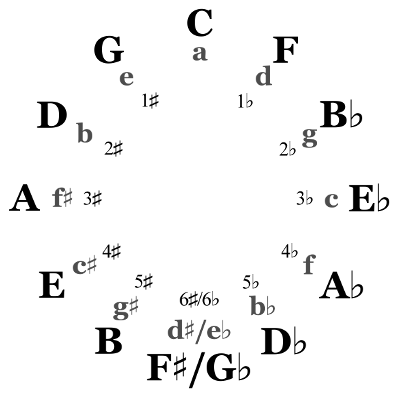The Cycle of Fourths
It occurred to me earlier that I’ve spelled out the Cycle of Fourths in sequence from C, but I haven’t provided a picture of what it looks like yet. Here’s a brief summary and some links to more info, and for redundancy’s sake, here’s the sequence again:
C – F – Bb – Eb – Ab – Db – Gb – B – E – A – D – G
And, here’s a picture of the Cycle, in all its glory. This is the one I’ve been referencing since I first blogged about it. Its the first image that comes up in Google when you search for “Cycle of Fourths”. Its originally from a guitar site called Deft Digits.
Now, on to some info about the Cycle:
- Its alternately called the Cycle of Fourths or Circle of Fourths
- It includes all of the 12 notes in western music, from A to G, and thus has 12 positions, like a clock
- Instead of moving alphabetically, it moves in fourths, so (this is easiest to understand if we start on A – the 9:00 position):
- If A-B-C-D is 1-2-3-4 then A is the 1 and D is the 4, so moving a 4th from A is D
- If D-E-F-G is 1-2-3-4 then D is the 1 and G is the 4, so moving a 4th from D is G
- If G-A-B-C is 1-2-3-4 then G is the 1 and C is the 4, so moving a 4th from G is C
- If C-D-E-F is 1-2-3-4 then C is the 1 and F is the 4, so moving a 4th from C is F, etc.
- The first BEADG letters that appear are flatted (Bb, Eb, Ab, Db, Gb) and the next aren’t
- Later on, in music theory this lets people easily know the numbers of sharps or flats in a key, but I’m not ready for that yet
- Moving clockwise from one note to the next goes in fourths. Counterclockwise goes in fifths
- If you pick a note (say, C) and move one note to the right (F), you’ve moved a 4th
- If you pick a note (say, C) and move one note to the left (G), you’ve moved a 5th
- Because of that, you can look at a note and its 2 closest neighbors and know where to go for a I-IV-V progression
- If we start on C, then a I-IV-V progression would be C-F-G
Here are the two links I found most useful when I was reading about it a month ago:
- StudyBass: The Circle of Fifths Diagram (yeah, it starts with the Circle of Fifths, but just read it)
- Deft Digits: How to Memorize and Use the Cycle of Fourths






Pingback: Coursera – Developing Your Musicianship Lesson 2 | Ugly Bass Face
Pingback: Coursera – DYM Lesson 2 videos (3) | Ugly Bass Face
Pingback: Carol Kaye Interview | Ugly Bass Face
Pingback: Recommendations to Newbies | Ugly Bass Face
Pingback: Coursera – DYM Lesson 5 videos (5) | Ugly Bass Face
Pingback: Memorizing the Fretboard using the Cycle of Fourths | Ugly Bass Face
Pingback: Warm-up for this week (03.24.15) | Ugly Bass Face
Pingback: Warm-up for this week: Minor Scale exercise | Ugly Bass Face
Pingback: HLBM 06: Notes on the E-String | Ugly Bass Face
Pingback: Target and Approach Tones – Shaping Bebop Lines (by Joe Riposo) | Ugly Bass Face
Pingback: MalcolmAmos and the Circle of Fifths | Ugly Bass Face
Pingback: Talkingbass.net – Cycle Of 4ths and Notes On The Neck Combined | Ugly Bass Face
Pingback: No Schecter Riot-5 bass for me, but I’m learning the fretboard! | Ugly Bass Face